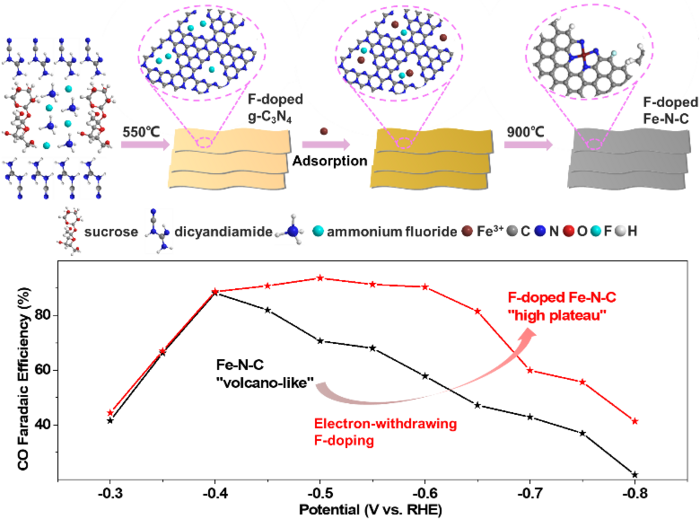As industry has developed over the past century, excess carbon dioxide emission had led to climate problems and greenhouse effects. Scientists are constantly working toward solutions for the problems of greenhouse gases, which are warming the earth’s surface and the lower parts of the atmosphere. Carbon dioxide is the most prevalent of the greenhouse gases.

Credit: Nano Research
As industry has developed over the past century, excess carbon dioxide emission had led to climate problems and greenhouse effects. Scientists are constantly working toward solutions for the problems of greenhouse gases, which are warming the earth’s surface and the lower parts of the atmosphere. Carbon dioxide is the most prevalent of the greenhouse gases.
Carbon dioxide can be electrochemically reduced into valuable chemicals using wind or sunlight-derived electrical energies. This carbon dioxide electroreduction presents scientists with a promising strategy for managing the carbon balance on a global scale. Electrochemical reduction of carbon dioxide offers the future potential for converting the carbon dioxide into useful, more environmentally friendly chemicals, such as carbon monoxide, methane, or ethanol. To achieve carbon dioxide electroreduction, scientists need efficient electrocatalysts. Electrocatalysts are the catalysts used in electrochemical reactions. They can increase the rate of the reaction that occurs. A research team from Nanjing University has constructed catalysts using a fluorine-doping method that enhances their performance.
The research team reported their findings on May 1, 2022 in the journal Nano Research. (DOI 10.1007/s12274-022-4441-0)
Scientists know that low-cost metal-nitrogen-carbon single-site catalysts work well for carbon dioxide electroreduction to carbon monoxide. Among these, the nickel-nitrogen-doped carbon single-site catalysts possess the high faradaic efficiency of carbon monoxide and large partial current. The faradaic efficiency describes how efficiently charge is transferred in an electrochemical reaction.
The research team has already boosted the faradaic efficiency and large partial current of nickel-nitrogen-doped carbon single-site catalysts by doping them. By comparison with the nickel-nitrogen-doped carbon single-site catalysts, iron-nitrogen-carbon single-site catalysts have lower overpotentials for carbon dioxide electroreduction. Overpotential describes a cell’s voltage efficiency. Pervious research has used X-ray absorption fine structure spectroscopy to verify that the active sites of the iron-nitrogen-carbon single-site catalysts are Fe3+ sites. These Fe3+ sites allow the catalyst to be more effective in carbon dioxide adsorption and carbon monoxide desorption.
The research team constructed a fluorine-doped iron-nitrogen-carbon single-site catalyst which possesses more Fe3+ sites, as they expected. The fluorine-doped iron-nitrogen-carbon single-site catalyst they constructed maintained the advantage of low overpotential. It also promoted the carbon monoxide faradaic efficiency from a volcano-like high value to a high plateau value. “The results indicate the superior stability of fluorine-doped iron-nitrogen-carbon to iron-nitrogen-carbon because of the fluorine-doping,” said Lijun Yang, an associate professor from School of Chemistry and Chemical Engineering, Nanjing University.
The research team concludes that the electron-withdrawing fluorine-doping allows the iron-nitrogen-carbon single-site catalyst to maintain the advantage of low overpotential, with a much increased carbon monoxide faradaic efficiency and partial current density because of the stabilized Fe3+ sites.
The team synthesized the iron-nitrogen-carbon using a heat method called adsorption pyrolysis. They performed the carbon dioxide electroreduction experiments in a H-type cell and a gas diffusion electrode cell. They used theoretical calculations to further understand the improvements that happened with the fluorine doping.
“Electrochemical tests show the enriched defects by fluorine-doping kinetically increase the electroactive surface area and improve charge transfer,” said Yang. Looking ahead to further study, the research team’s findings provide them with a simple and controllable strategy to enhance the carbon dioxide electroreduction to carbon monoxide performance of iron-nitrogen-carbon catalysts by stabilizing the Fe3+ sites.
The research team includes Yiqun Chen, Guochang Li, Yu Zeng, Lijie Yan, Xizhang Wang, Lijun Yang, Qiang Wu, Zheng Hu from Nanjing University.
The research is funded by the National Key Research and Development Program of China, the National Natural Science Foundation of China, the Natural Science Foundation of Jiangsu Province, Major Project, and Nanjing University Innovation Program for PhD candidate.
The paper is also available on SciOpen (https://www.sciopen.com/article/10.1007/s12274-022-4441-0) by Tsinghua University Press.
##
About Nano Research
Nano Research is a peer-reviewed, international and interdisciplinary research journal, sponsored by Tsinghua University and the Chinese Chemical Society. It offers readers an attractive mix of authoritative and comprehensive reviews and original cutting-edge research papers. After more than 10 years of development, it has become one of the most influential academic journals in the nano field. Rapid review to ensure quick publication is a key feature of Nano Research. In 2020 InCites Journal Citation Reports, Nano Research has an Impact Factor of 8.897 (8.696, 5 years), the total cites reached 23150, and the number of highly cited papers reached 129, ranked among the top 2.5% of over 9000 academic journals, ranking first in China’s international academic journals.
About SciOpen
SciOpen is a professional open access resource for discovery of scientific and technical content published by the Tsinghua University Press and its publishing partners, providing the scholarly publishing community with innovative technology and market-leading capabilities. SciOpen provides end-to-end services across manuscript submission, peer review, content hosting, analytics, and identity management and expert advice to ensure each journal’s development by offering a range of options across all functions as Journal Layout, Production Services, Editorial Services, Marketing and Promotions, Online Functionality, etc. By digitalizing the publishing process, SciOpen widens the reach, deepens the impact, and accelerates the exchange of ideas.
Journal
Nano Research
DOI
10.1007/s12274-022-4441-0
Article Title
Boosting faradaic efficiency of CO2 electroreduction to CO for Fe-N-C single-site catalysts by stabilizing Fe3+ sites via F-doping
Article Publication Date
4-Jun-2022




